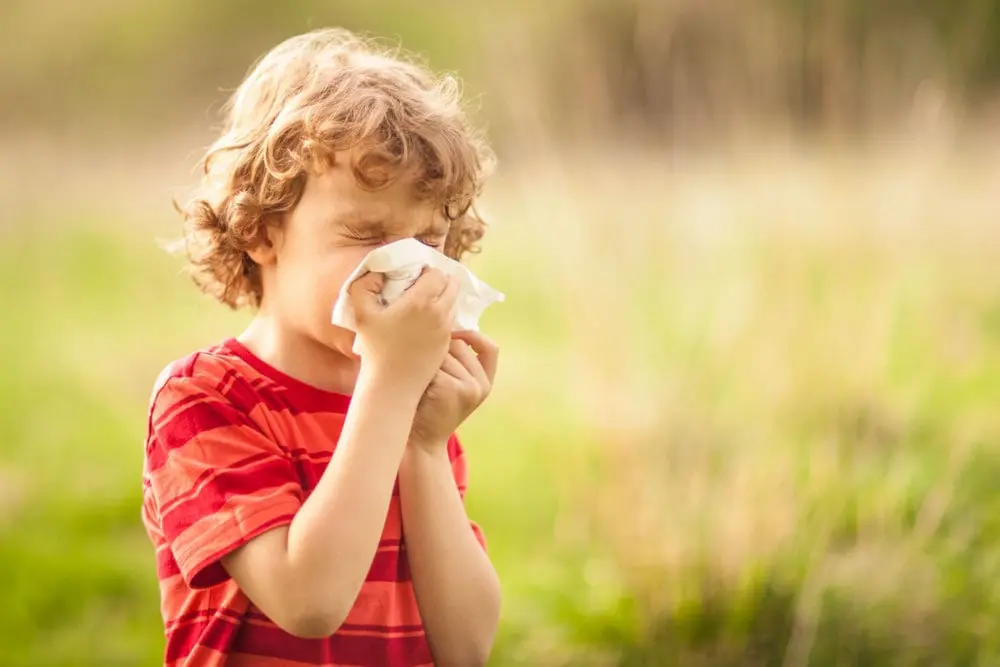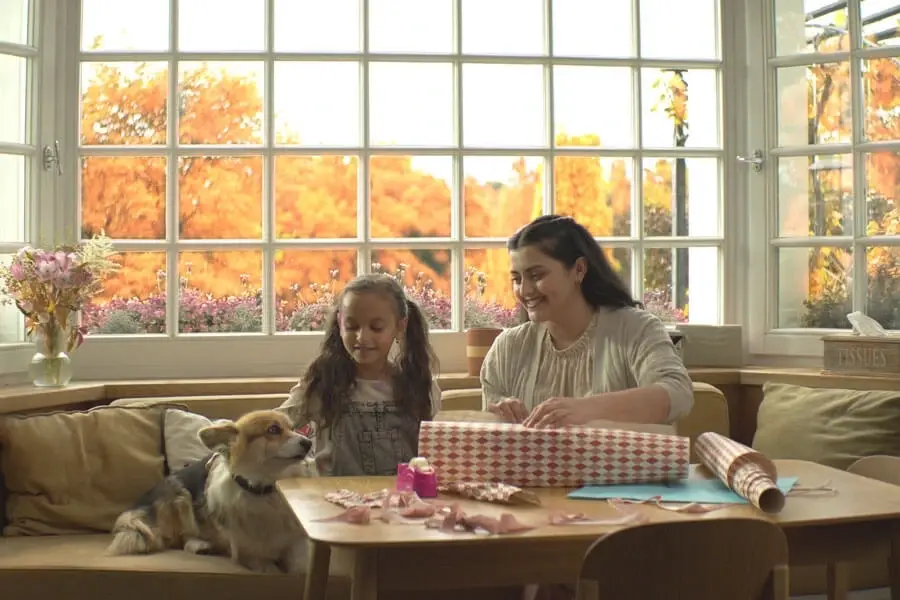Just like with adults, kids’ allergies are caused when the body’s immune system reacts to an allergy trigger, such as pollen, pet dander, or dust mites. Annoying allergy symptoms in kids are similar to adults, such as sneezing, wheezing, itchy eyes and skin, and rashes. Unfortunately, allergies can run in the family —if one parent has allergies, there's a 25% chance their children will have allergies, too. If both parents have allergies, the likelihood jumps all the way up to 60% to 70%!1 If you have allergies, you know firsthand how miserable they can feel, even if your kid can’t tell you. Fortunately, there are steps you can take to help prevent and treat your child’s allergy symptoms. Usually though, children under the age of 2 years don’t have respiratory allergies, so if you have a little one who appears to be experiencing symptoms, talk to your pediatrician.
Allergies don’t have to get in the way of your kids’ fun. Keep reading to learn more about allergy symptoms in kids, common triggers, and how to manage symptoms.
Allergy Symptoms in Kids
If you suspect your child has allergies, look at their symptoms. The following are some common allergy symptoms in kids:2
Runny nose, itchy nose, or sneezing are common symptoms of allergies in kids. They can also have nasal congestion or postnasal drip (drainage from the nose down the back of the throat).
Itchy eyes or roof of the mouth can be symptoms of allergies in kids. If children rub their face, eyes, or nose constantly, it may be a sign of allergies.
Skin rash symptoms can include redness, itchy skin, dry skin, hives, bumps, or welts.
Children may suffer severe, life-threatening allergic reactions (anaphylaxis) requiring immediate/emergency medical attention.3 Signs and symptoms of anaphylaxis include:
Tightness or swelling of the throat or tongue
Wheezing, trouble breathing, or tightness in the chest
Widespread rash or hives
Severe itching of the skin
Stomach pain, vomiting, or diarrhea
Weak pulse or heartbeat
Loss of bladder control
Confusion or agitation
Dizziness or fainting
Anaphylaxis can happen seconds, minutes, or hours after exposure to a trigger, but requires immediate medical care.
It is important to note that BENADRYL® is not indicated for the treatment of anaphylaxis. If you or your child have severe allergies, talk to your doctor about which medications are best for you.
Common Children’s Allergy Triggers
To help manage your child’s allergies, identify and avoid the triggers as best as you can. Many things can trigger allergic reactions in children. Here are some of the most common allergy triggers:2,4
Indoors - dust mites, pets, mold, and cockroaches
Outdoors - pollen, grass, ragweed, mold, biting insects
Pets - dander, saliva, or urine from pets
Foods - peanuts, eggs, milk, wheat, soy, tree nuts, fish, shellfish
Medications - antibiotics, pain relievers, vaccines
BENADRYL® is indicated to treat symptoms of hay fever and allergy symptoms such as runny nose, sneezing, itchy/water eyes, itchy throat, and itchy nose.
Here are some simple steps you can take to reduce your child’s exposure to allergens, both around the house and while outdoors:
Cut the Clutter
Knickknacks collect dust and are hard to clean. Store children’s toys, games, and stuffed animals in plastic bins to get rid of those dust-collectors.Laundry-Line Farewell
Hanging laundry outside can attract pollen, causing your child’s allergies to flare up. Use a dryer instead.
How To Tell if Your Child Has Allergies
Your child may have allergies if they have the symptoms listed above, such as runny nose, nasal congestion, coughing, itchy eyes, skin rash, or sore or itchy throat.
Observe the Timing of Their Symptoms
Sometimes allergies are year-round, and sometimes allergies occur during a certain season, so identifying when your child is presenting symptoms can be key in figuring out the type of allergies they are suffering from.
Seasonal allergies flare up during a certain time of year, and are triggered by pollen, mold, grass, and weeds.
Year-round allergies usually flare up when you are indoors, and they are triggered by dust mites, pet dander, or mold.
Sometimes it can be difficult to tell the difference between seasonal and year-round allergies, especially in little ones who can’t tell us how they feel. Learn more about how to tell the difference between seasonal versus year-round allergies.
In some cases allergy symptoms can even be worse at night than in the daytime. One of the most common triggers of nighttime allergies is dust mites. Dust mites are microscopic bugs that live in pillows, mattresses, bedding, carpet, and upholstery. Both body parts and waste from dust mites trigger allergies for many people.5
See if their Symptoms Might be Something Else
Allergy symptoms can also easily be mistaken for cold symptoms. However, understanding whether or not your child is suffering from a cold or allergies means taking a look at the whole picture. For example, allergies can cause itchy, watery eyes, but a cold won’t, which could be one way to help distinguish between the two.
Consider Speaking with a Doctor
To diagnose an allergy, your doctor will take a complete health history and examine your child. They may also do blood tests or skin tests for allergies.
Speak with your pediatrician if you believe your child is suffering from allergies.
How To Treat Children’s Allergies and Help Them Find Relief
By reducing exposure to allergy triggers, you can help your child find relief. Here are some considerations:
Play indoors when pollen or mold counts are high in your area.
Eliminate dust in your child’s room and at home by taking actions like reducing clutter and storing toys and clothing in bins.
Keep pets out of your child’s bed and bedroom.
Properly ventilate indoor living spaces.
Wash clothing, bedding, and plush toys regularly.
Use a dehumidifier to reduce humidity indoors below 50%.
Filter your air with an air conditioner or a high-efficiency particulate air (HEPA) filter.
Change furnace and air conditioner filters regularly, and clean air ducts.
Eliminate sources of dampness indoors that can lead to mold, such as leaks.
Remove carpet if possible, and vacuum regularly.
Keep windows closed, especially in your child’s bedroom at night.
Encourage your child to drink fluids and stay hydrated.
Bathe and wash your child’s clothes after being outdoors.
Use a warm compress to soothe sinus pressure.
Talk to your child’s caregivers—teachers, babysitters, coaches, parents of their friends—and bring them up to speed on your child’s allergies and their triggers.
Using Children’s BENADRYL® Allergy Medicine for Kids
If your child still has symptoms, find the right BENADRYL® product to help provide your child relief, and carefully read and follow the entire product label and dosing information before giving the medication. If symptoms persist, talk to your pediatrician.
Children’s BENADRYL® Allergy Liquid and Children's BENADRYL® Dye-Free Allergy Liquid Antihistamine Medicine provide kids with effective relief from hay fever and allergy symptoms. Made with 12.5 mg of diphenhydramine in each 5 mL, these medicines provide 4 to 6 hours of relief per dose of symptoms such as runny nose, sneezing, itchy or watery eyes, itchy throat, and itchy nose.
Children’s BENADRYL® Chewables provide relief from allergy symptoms in a grape-flavored chewable tablet made with 12.5 mg of diphenhydramine.
Children’s BENADRYL® Allergy Plus Congestion Nasal Decongestant & Sinus Medicine for Kids is a nasal decongestant and sinus medicine for kids. Made with 12.5 mg of diphenhydramine and 5 mg of phenylephrine in each 5 mL, this medicine provides relief for your child’s allergy and nasal congestion symptoms.
For children over the age of 2 years, BENADRYL® Extra Strength Spray can help relieve symptoms of itchy skin from rash or insect bites.
References
American Academy of Pediatrics. Allergies. November 21, 2015. Accessed from: https://www.healthychildren.org/English/health-issues/conditions/allergies-asthma/Pages/Allergies.aspx
Cedars-Sinai. Anaphylaxis in Children. Accessed from: https://www.cedars-sinai.org/health-library/diseases-and-conditions---pediatrics/a/anaphylaxis-in-children.html
American Academy of Pediatrics. Anaphylaxis in Infants and Children. September 30, 2019. Accessed from: https://www.healthychildren.org/English/health-issues/injuries-emergencies/Pages/Anaphylaxis.aspx
Allergy and Asthma Foundation of America. Control Indoor Allergens to Improve Indoor Air Quality. September 2015. Accessed from: https://www.aafa.org/control-indoor-allergens/
Allergy and Asthma Foundation of America. Dust Mite Allergy. October 2015. Accessed from: https://www.aafa.org/dust-mite-allergy/


